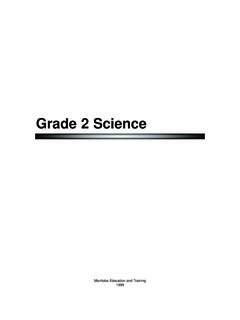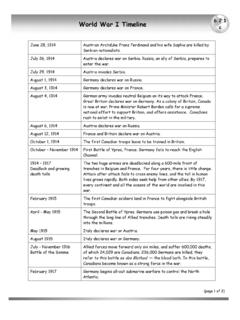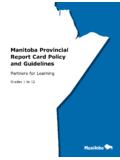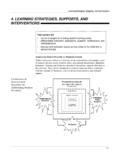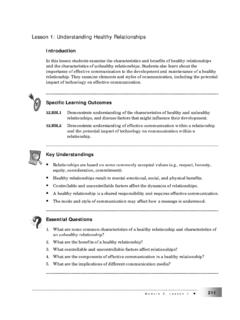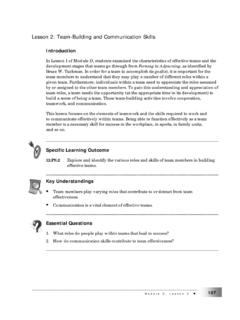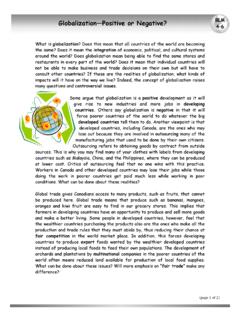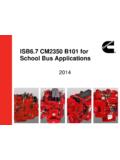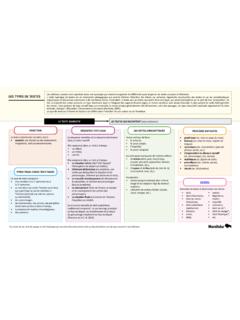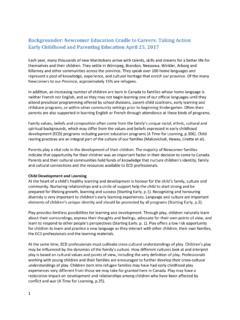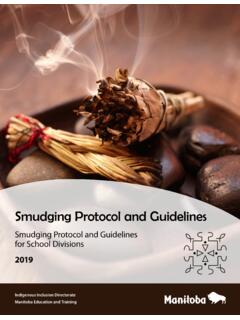Transcription of Peace and Conflict - Province of Manitoba
1 Peace and and ConflictIntroductionOver 80 percent of all humanitarian crises are the result of conf lict. Conf lict is an intrinsic and inevitable aspect of social change, but how we deal with this conf lict determines the impacts and outcomes of change. Understanding how conf lict can be managed, utilized, and transformed can help promote more peaceful resolutions and responses. But what is Peace and how is it accomplished?As Peace is a hypothetical construct, it is often easiest to define what Peace is not that is, conf lict. Conf lict is, from the Latin, to clash or engage in a fight, and occurs when two or more individuals or groups pursue mutually incompatible goals.
2 In fact, Peace and conf lict can take different forms, occurring on a number of levels with a wide variety of causes and outcomes. Peace and conf lict occur in various contexts, from the personal, family, school, and community levels to the international level. Peace and conf lict studies often involve an exploration of the interconnections among such issues as poverty, violence and non-violence, individual and overall security, hunger, discrimination, human rights, war and justice, freedom, and the human community. The interdisciplinary nature of Peace and conf lict studies means that teachers have lots of options in deciding what to teach and many opportunities to link their lessons with other topics or areas of and Conflict Exploring the Issues1.
3 Understanding Concepts of Peace and ConflictJohan Galtung, one of the founders in the field of Peace and conf lict studies, proposed interrelated models of conf lict, violence, and Peace . Conf lict is viewed as a dynamic process in which structure, attitudes, and behaviour are constantly changing and inf luencing one another. Direct violence is ended by changing conf lict behaviour, structural violence is ended by removing structural contradictions and injustices, and cultural violence is ended by changing attitudes. These relate in turn to broader strategies of peacekeeping, Peace building, and defined negative Peace as the absence of direct violence and positive Peace as the absence of all three forms of violence (direct, structural, and cultural).
4 Galtung s Models of Conflict , Violence, and PeaceConflictViolencePeaceContradictionB ehaviourAttitudeStructural violenceDirect violenceCultural violencePeacebuildingPeacekeepingPeacema king2. Preventing, Managing, and Resolving ConflictIt is important to remember that conf lict is an inherent part of the human condition but that violent conf lict can be prevented. There are a number of definitions and types of violence from the interpersonal to the global level ( , family violence, youth and gang violence, violence in the workplace, hate crimes, and war). Understanding the nature of violence may include discussion of social oppression, discrimination, and marginalization.
5 Managing and resolving or transforming conf lict can prevent the occurrence of are many aspects to conf lict escalation and de-escalation. Lessons may include the following: Stages of conf lict ( , difference to reconciliation) Strategic responses and skills and processes used in response ( , problem solving, preventative peacekeeping, decentralization of power, etc.) and Conflict Approaches to conf lict ( , withdrawal, compromise, yielding, etc.) The differences among positions, interests, and needs (interests are often easier to resolve than positions) Third-party intervention (coercive versus non-coercive forms) Different forms of power Symmetrical versus asymmetrical conf licts (see Glossary section) Non-violent forms of resistance Contemporary and indigenous systems for resolving conf lict and Peace building3.
6 Branches of Peace and Conflict StudiesTeachers may wish to focus in on one of the many branches of Peace and conf lict studies. Some of these include the following: Culture, Peace , and conf lict ( , the impact of cultural norms and world views on approaches to conf lict management, ways in which cultural difference can become a source of conf lict as well as a resource for peacemaking, for culturally sensitive approaches to conf lict-resolution training and social change, and for localizing Peace , etc.) Ethics of conf lict resolution ( , ethics of conf lict intervention) Gender, Peace building, and conf lict ( , the impact of conf lict on women and children, the role of women in Peace building, UN Resolution 1325, etc.)
7 International Peace and conf lict ( , causes of conf lict and approaches for Peace ) Media, Peace , and conf lict Peace education ( , how to promote Peace in the classroom, how educators can serve as role models, etc.) and Conflict Essential QuestionsInquiry questions related to Peace and conf lict issues may include the following: What elements should be present/absent in order for Peace to occur? Are there different kinds of Peace ? Can you describe them? What effect does inner Peace have on external circumstances? How does Peace relate to conf lict? Is conf lict always negative? Can you think of an instance where conf lict might be positive?
8 What is the media s role in promoting war? Aside from the individuals/groups in conf lict, who else is affected by conf lict ( , innocent civilians in national armed conf licts, children in parental conf licts, etc.)? How are they affected ( , emotionally, physically, intellectually, etc.)? How do people of different ages or gender experience and/or deal with conf lict differently? Should conf lict resolution be different in different cultures? What are the current conf licts in your school? ..community? ..country? ..other countries? What are some ways these could be resolved/transformed? What are sustainable forms of Peace ?
9 How can they be achieved? Who needs to be involved? It is estimated that 22 of the 34 countries furthest away from achieving the United Nation s Millennium Development Goals are affected by current or recent conf licts (United Nations Development Programme). Of the 20 poorest countries, 16 have recently experienced civil war, resulting in severe hunger and poverty. Why do you think this is? How does development relate to conf lict? How does this help us understand current conf licts? What might this suggest about Peace ? Youth have an important role to play in Peace and conf lict. In contemporary armed conf licts, youth are often on the frontlines of combat and, after Peace accords are signed, they are both potential threats to Peace and significant Peace -building resources (Carey, 2007).
10 Why do youth have such an impact on Peace and conf lict? What do you see as youth s role in conf lict and Peace ?? and ConflictDid You Know? 90 percent of modern war casualties are civilians primarily women and children. Save the Children (CTP) Armed Conflict has declined by more than 40 percent since 1992. Washington Post (CTP) conflicts have produced 31 million refugees and other displaced persons, most of them women and children. Rotary International (CTP) War has killed 2 million children in the last 20 years. Peace Pledge Union (CTP) In the last 5,600 years, there have been only 292 years of Peace .
